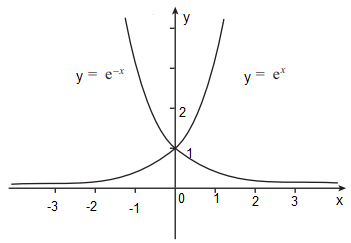
Answer the following question in one word or one sentence or as per exact requirement of the question.
If A = {(x, y): y =${{\text{e}}^{\text{x}}}$, x ϵ R} and B = {(x, y): y =${{\text{e}}^{{\text{ - x}}}}$, x ϵ R}, then write A ∩ B.
Answer
599.7k+ views
Hint: To determine the answer, we write the definition of A ∩ B using the given A and B. Then we perform the calculations to get the values of x and y. Definition of A ∩ B states that the set of elements which are common in both sets A and B.
Complete step-by-step solution -

We need: A ∩ B
⟹ {(x, y): y =${{\text{e}}^{\text{x}}}$, x ϵ R} ∩ {(x, y): y =${{\text{e}}^{{\text{ - x}}}}$, x ϵ R}
⟹ {(x, y): y =${{\text{e}}^{\text{x}}}$∩ ${{\text{e}}^{{\text{ - x}}}}$, x ϵ R}
The intersection of ${{\text{e}}^{\text{x}}}$and ${{\text{e}}^{{\text{ - x}}}}$is nothing but,
⟹${{\text{e}}^{\text{x}}}$=${{\text{e}}^{{\text{ - x}}}}$
Applying ln on both sides we get,
⟹ln ${{\text{e}}^{\text{x}}}$= ln ${{\text{e}}^{{\text{ - x}}}}$
We know ln (${{\text{e}}^{\text{x}}}$) = x ln e = x (1) = x -- ln (e) = 1, logarithmic identity.
⟹x = -x
⟹2x = 0
⟹x = 0
Therefore, ${{\text{e}}^{\text{x}}}$= ${{\text{e}}^{{\text{ - x}}}}$= ${{\text{e}}^0}$= 1
Hence y = 1.
At x = 0, y = 1
Therefore, A ∩ B = {(0, 1)} is a singleton set.
Note: The key in such problems is to understand the definition of A ∩ B using the given A and B. A intersection B refers to a common solution set of A and B. Using the correct operations, like applying the log function to reduce the equations and finding the values of x and y is a crucial step.
Any number to the power of 0 is 1. e is a numerical constant with a value of 2.71828.
Complete step-by-step solution -

We need: A ∩ B
⟹ {(x, y): y =${{\text{e}}^{\text{x}}}$, x ϵ R} ∩ {(x, y): y =${{\text{e}}^{{\text{ - x}}}}$, x ϵ R}
⟹ {(x, y): y =${{\text{e}}^{\text{x}}}$∩ ${{\text{e}}^{{\text{ - x}}}}$, x ϵ R}
The intersection of ${{\text{e}}^{\text{x}}}$and ${{\text{e}}^{{\text{ - x}}}}$is nothing but,
⟹${{\text{e}}^{\text{x}}}$=${{\text{e}}^{{\text{ - x}}}}$
Applying ln on both sides we get,
⟹ln ${{\text{e}}^{\text{x}}}$= ln ${{\text{e}}^{{\text{ - x}}}}$
We know ln (${{\text{e}}^{\text{x}}}$) = x ln e = x (1) = x -- ln (e) = 1, logarithmic identity.
⟹x = -x
⟹2x = 0
⟹x = 0
Therefore, ${{\text{e}}^{\text{x}}}$= ${{\text{e}}^{{\text{ - x}}}}$= ${{\text{e}}^0}$= 1
Hence y = 1.
At x = 0, y = 1
Therefore, A ∩ B = {(0, 1)} is a singleton set.
Note: The key in such problems is to understand the definition of A ∩ B using the given A and B. A intersection B refers to a common solution set of A and B. Using the correct operations, like applying the log function to reduce the equations and finding the values of x and y is a crucial step.
Any number to the power of 0 is 1. e is a numerical constant with a value of 2.71828.
Recently Updated Pages
Master Class 12 Economics: Engaging Questions & Answers for Success

Master Class 12 Maths: Engaging Questions & Answers for Success

Master Class 12 Biology: Engaging Questions & Answers for Success

Master Class 12 Physics: Engaging Questions & Answers for Success

Master Class 8 Maths: Engaging Questions & Answers for Success

Class 8 Question and Answer - Your Ultimate Solutions Guide

Trending doubts
What is meant by exothermic and endothermic reactions class 11 chemistry CBSE

10 examples of friction in our daily life

One Metric ton is equal to kg A 10000 B 1000 C 100 class 11 physics CBSE

1 Quintal is equal to a 110 kg b 10 kg c 100kg d 1000 class 11 physics CBSE

Difference Between Prokaryotic Cells and Eukaryotic Cells

What are Quantum numbers Explain the quantum number class 11 chemistry CBSE




